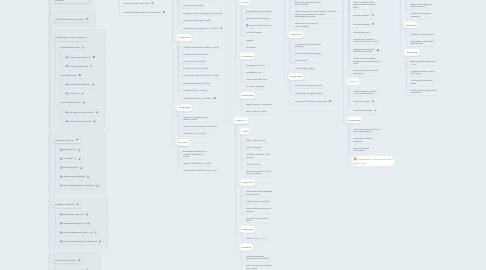
1. Cognitive Development Theories
1.1. Gesell's Maturational Theory
1.2. Social Learning Theory
1.3. Kohlberg's Moral Theory
1.3.1. Pre-conventional Level
1.3.1.1. Punishment & Obedience
1.3.1.2. Instrumental Exchange
1.3.2. Conventional Level
1.3.2.1. Interpersonal Conformity
1.3.2.2. Law & Order
1.3.3. Post-conventional Level
1.3.3.1. Prior Rights & Social Contract
1.3.3.2. Universal Ethical Principles
1.4. Freud's Theory
1.4.1. Oral Stage (0-1)
1.4.2. Anal Stage (1-3)
1.4.3. Phallic Stage (3-6)
1.4.4. Latency Stage (6-puberty)
1.4.5. Genital Stage (puberty to adulthood)
1.5. Piaget's Theory
1.5.1. Sensorimotor Stage (0-2)
1.5.2. Preoperational Stage (2-7)
1.5.3. Concrete Operational Stage (7-12)
1.5.4. Formal Operation Stage (12-adulthood)
1.6. Erikson's Theory
1.6.1. Basic Trust vs. Mistrust (0-1)
1.6.2. Autonomy vs. Shame Doubt (1-3)
1.6.3. Initiative vs. Guilt (3-6)
1.6.4. Industry vs. Inferiority (6-12)
1.6.5. Identity vs. Role Confusion (12-20)
1.6.6. Intimacy vs. Isolation (20-40)
1.6.7. Generativity vs. Stagnation (40-65)
1.6.8. Ego Integrity vs. Despair (65+)
2. Newborn
2.1. Developmental Assessments
2.1.1. Apgar Score
2.1.2. Ballard Neonatal Examination
2.1.3. Brazelton Neonatal Behavioral Assessment
3. Infant 0-12 months
3.1. Motor
3.1.1. Rolling over (4-6 months)
3.1.2. Sitting independently (8-9 months)
3.1.3. Walking (10-15 months)
3.1.4. Grasping & reaching for objects (3-6 months)
3.1.5. Picking up objects (By 9 months)
3.1.6. Mastering a pincer grasp (10-11 months)
3.2. Cognitive
3.2.1. Visually track objects to midline (1 month)
3.2.2. Track past midline (2 months)
3.2.3. Turn to sounds (3 months)
3.2.4. Binocular Vision (3-6 months)
3.2.5. Turn towards origin of a sound (4 months)
3.2.6. Depth perception (6-8 months)
3.2.7. Localize sound (12 months)
3.2.8. Object Permanence (7-9 months)
3.3. Language
3.3.1. Varies cries to signify various needs (1 month)
3.3.2. Produce consonant sound (4-6 months)
3.3.3. First words (10-12 months)
3.4. Physical
3.4.1. Birthweight doubles by 4-5 months and triples by 12 months
3.4.2. Length is doubled by 12 months
3.4.3. Head growth increases 12 cm by 1 year
4. Toddler
4.1. Ages 1-2
4.1.1. Motor
4.1.1.1. Begin walking independently
4.1.1.2. Squat to pick something up
4.1.1.3. Begin running (closer to 2)
4.1.1.4. Kick a ball forward
4.1.1.5. Scribble
4.1.1.6. Turn knobs
4.1.2. Cognitive
4.1.2.1. Recognizes first name
4.1.2.2. Understands "no"
4.1.2.3. Able to point with finger
4.1.2.4. Waves "goodbye"
4.1.3. Language
4.1.3.1. Begin to say "no" to requests
4.1.3.2. Uses "mama" or "dada"
4.2. Ages 2-3
4.2.1. Motor
4.2.1.1. Begin to ride a tricycle
4.2.1.2. Catch a large ball
4.2.1.3. Walk down stairs with 2 feet per step
4.2.1.4. Use a fork to eat
4.2.1.5. Use one hand more than the other for activities
4.2.2. Cognitive
4.2.2.1. Understands simple questions and commands
4.2.2.2. Holds up fingers to tell age
4.2.2.3. Likes to hear same story over and over
4.2.2.4. Can give first name when asked
4.2.3. Language
4.2.3.1. Learn to count "1, 2, 3"
4.2.4. Physical
4.2.4.1. Voluntarily postpone elimination (15-18 months)
4.2.4.2. Able to remain dry during the day (2 years)
4.2.4.3. Most are fully bowel trained (4 years)
5. Preschooler
5.1. Motor
5.1.1. Learning to skip (4 years)
5.1.2. Ride a bicycle with training wheels (5 years)
5.1.3. Able to draw circles, crosses, squares, faces with bodies, cut with scissors, use toilet independently (3-5 year)
5.1.4. Able to print his or her first name (4-5 years)
5.2. Cognitive
5.2.1. Play matures from symbolic to imaginary
5.2.2. Joint/associative play emerges
5.2.3. Learn to share
5.2.4. Learn through imitation
5.3. Language
5.3.1. Full of "why" questions (3 years)
5.3.2. At least 90% intelligible (5 years)
5.3.3. Mean length of utterance equals age
6. Middle Childhood 6-12
6.1. Cognitive
6.1.1. Conservation develops
6.1.2. Able to consider another person's point of view (10 years)
6.1.3. Seriation develops
6.1.4. Transivity develops
6.1.5. Memory improves
6.1.6. Compare their personal qualities to others (6-7 years)
6.1.7. Recognize psychological attributes (8-10 years)
6.1.8. Able to consider multiple perspectives simultaneously (12 years)
6.1.9. Belong to primarily same-sex peer groups
6.2. Physical
6.2.1. Growth of about 2.3 inches and 13 pounds per year
6.2.2. Hormonal changes
6.2.3. Neurological changes
6.3. Language
6.3.1. Learn that two words can have similar meanings (5-6)
6.3.2. Use long and complex sentences
6.3.3. Start and continue conversations
6.3.4. Learning to read, write, and spell (5-6)
7. Adolescent 12-19
7.1. Cognitive
7.1.1. Follow complicated instructions
7.1.2. Consider many points of view
7.1.3. Begins to think long-term (career decisions)
7.1.4. Questions and analyzes extensively
7.2. Physical
7.2.1. Adolescent "Growth Spurt"
7.2.2. Sleep patterns shift toward later bedtimes
7.3. Language
7.3.1. Begin understanding sarcasm (11-14)
7.3.2. Understand and use "slang" with friends
7.3.3. Tell long and complicated stories
7.3.4. Be able to change topic well in conversation
